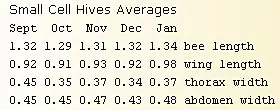Unveiling the Wonders of Seasonal Bee Sizes

Greetings Bee Lovers! 🌸🐝 Ever wondered about the intricate world of seasonal bee sizes?
Dive into my journey, where we explore the impact of cell size and seasonal influences on these buzzing wonders.
In my test yard, I set up colonies with both large and small cells. Sounds simple, right? But identifying which hives were which by merely observing the forager bee size turned out to be quite the challenge.
Let’s break down the fascinating findings as we measure flying bees from large and small cell hives over time. We’re talking bee length, wing length, thorax width, and abdomen width. Brace yourself for some bee-measuring action!
Data Highlights:
- September: Large cell bees strut their stuff, slightly larger than their small cell counterparts.
- November: Small and large cell bees play the size equality game.
- October to November: Abdomen width sees a boost in all colonies.
- February: Newly hatched bees from both large and small cell hives resemble the petite early spring small cell bees.
- May: The larger overwintered bees bid adieu, leaving us with a uniform, smaller-sized bee squad.
- July: Bees slightly beef up compared to May, but no sign of the typical spring small cell-sized bees. Large cell bees edge out a tad larger than their small cell buddies.
- August: The bee sizes start diverging, paving the way for slightly different-sized September bees.
After a whopping 1500 measurements, some subtle differences in bee size within a hive throughout the year become visible. However, distinguishing between small cell and large cell bees remains a puzzle without keeping records. The variation within a hive throughout the year is as much as between different cell size hives.
First Season Shenanigans
The initial spring brood from small cell hives birthed smaller bees than the overwintered ones raised on larger cell-sized comb. Yet, by midsummer, no small cell bees were in sight. The mystery deepened when even a fellow beekeeper, Barry Birkey, couldn’t spot a difference in his foraging bees’ size.
Fast forward to winter monitoring, and lo and behold, those small cell hive bees gradually grew larger. The size difference became apparent when the first spring brood emerged—quite the case of small bees in large cell comb, or so it seemed.
Second Season Surprises

Fast forward to the second season. A severe drought took a toll on spring bee forage, and brood rearing started dwindling. In a bid to bolster the small cell bees, large cell frames filled with granulated honey were introduced. The outcome? Queens defying excluders and laying a plethora of worker brood in the bottom super of large cell-sized comb, defying small cell literature.
With excluders out of the picture, small cell hives ended up with a box full of large cell brood. Catastrophe or a unique chance to compare large and small cell bees from the same hive, under the same queen, at the same time?
To my surprise, when the larger cell brood emerged, there was no sign of fat, long, large cell-sized bees. All the bees looked exactly the same. What a twist!
Third Season Triumphs

Expanding hive and yard count in the third season, I incorporated both large and small cell comb in each hive. Small cell frames nestled within large cell brood boxes resulted in flourishing hives with no noticeable size differences among the bees. The natural mite drop remained impressively low.
A top bar hive experiment revealed that by season’s end, the comb was no longer confined to large or small cells but displayed a full range of natural-sized cells.
Large or Small Cell Bees?
The ultimate test arrived. Three all-large cell hives in clean equipment were visually compared to large and small cell hives. Surprisingly, little to no size difference was observed between the bees.
The Revelation
As I donned my metaphorical new glasses, a digital version, and monitored seasonal bee size through photos with included scales, intriguing patterns emerged. Measurements included bee length, wing length, thorax width, and abdominal width.
Here’s a peek at some findings:
 -Small cell colony averages.
-Small cell colony averages.
 -Large cell colony averages.
-Large cell colony averages.
Feast your eyes on measurements for a ’typical’ large and a ’typical’ small cell hive:
 -Small cell colony measurements.
-Small cell colony measurements.
 -Large cell colony measurements.
-Large cell colony measurements.
Come September, large cell bees outsize their small cell counterparts. But by November, small and large cell bees play the size harmony, born from different-sized cell combs.
As we navigate through this intricate world of bee size, let these observations linger in your thoughts. While subtle, they challenge preconceptions and highlight the beauty of nature’s unpredictable dance.
The Beekeeping Odyssey
The bee size test almost did my beekeeping spirit in. Years of mite counts, experiments, and observations brought me to a profound realization. All the joy and wonder I once found in beekeeping had waned. It became clear that I was merely coasting on momentum, fueled by habit.
A turning point came when I recognized that my living no longer depended on the bees, and I couldn’t find a compelling reason to persist. Plans to sell or give away the bees were in motion.
Yet, destiny took a different turn. The bees essentially managed themselves for over a year. I saw them a handful of times and did not intervene. They thrived, emphasizing a newfound approach to beekeeping.
Today, my beekeeping philosophy has shifted. I engage with them when necessity calls, not because they need me. Given the right circumstances, they flourish independently.
It’s a humbling revelation for this devoted beekeeper but also a liberating concept. Almost a decade, countless mites, hive losses, computer hours, and 1500 bee measurements later, the truth hit me—the natural way isn’t just better for the bees; it’s better for the beekeeper too.
Embrace the beekeeping journey, let nature lead the dance, and may the bees thrive!
-Buzzing with joy, D 🐝🤠
